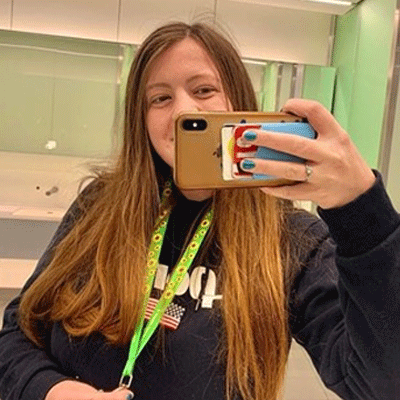
In this guest blog, Emma Cathro shares her tips on travelling with a non-visible disability. Emma is Type 1 Diabetic and a proud Sunflower wearer on her adventures abroad! Emma is also a FCDO Travel Aware Ambassador, helping people to travel abroad safely while sharing her experiences of travelling with a hidden disability.
Preparing to go away on holiday can be a stressful time but it can be even more complicated if, like me, you have a hidden disability. That’s why I’ve chosen to share my experience of travelling as a Type 1 Diabetic to help others with hidden disabilities, to provide some tips, tricks and travel advice.
My absolute top tip for travelling through an airport with a hidden disability is to get yourself a Sunflower lanyard. We’ve all seen people with the Sunflower lanyard during the pandemic, but did you know that people have been wearing these lanyards in the UK since 2016? The Sunflower lanyard scheme was created at Gatwick Airport in 2016 as the Accessibility Team at Gatwick realised the difficulties many passengers with disabilities faced during their time at the airport. You can use the lanyard for any invisible condition you may have, whether it is a medical condition such as a chronic illness, a mental health condition such as anxiety, a learning difficulty, or a neurological condition such as autism.
IMPORTANT!
If you are travelling with a pre-existing condition, it is so important to have travel insurance with the correct health cover in case you need treatment abroad, even if it is unrelated to your pre-existing condition. The Foreign, Commonwealth and Development Office (FCDO) has been working with airports, including Gatwick, to remind passengers at the airport to get the right travel insurance, to check travel advice and to sign up for email alerts so even if you do forget before your holiday, you should hopefully see their digital messages as you travel through to remind you! It’s really important to declare any pre-existing medical conditions. For example, if I didn’t declare that I have diabetes and I break my leg abroad, my travel insurance could be made invalid, even though a broken leg is not at all related to my pre-existing condition. As we don’t pay for treatments under the NHS it might be shocking to know that if you break your leg in Spain you would need to pay up to £15,000 for treatment and flights back home - so buy your travel insurance and declare your pre-existing conditions!
By using the lanyard, travellers can subtly signal to airport staff that they may require additional help or may need more time either at check-in, security, and/or boarding the plane. The trial at Gatwick went so well that the Sunflower lanyard is recognised in all UK airports and it’s even spread to other industries within the UK and other airports abroad, so be sure to check if your holiday destination recognises the lanyard too!
Some people may shy away from the lanyard because they don’t want to stand out, be the only one wearing the lanyard, or perhaps they don’t see their condition as a disability. It might be interesting to know that 1 in 7 people in the world have a disability and of that, 80% are hidden disabilities, which works out to be around 1 billion people – so you are definitely not alone!
I got my lanyard from the Special Assistance Office at Edinburgh Airport as I arrived at check-in. It was very simple: I explained I was diabetic, then they offered me a lanyard straight away and any further assistance. I didn’t need anything further, but if you do need any extra support, regardless of whether you wear a lanyard or not, it’s worth checking in advance how the Special Assistance team at your airport can support you on the day. If you don’t want to wait until you get to the airport, students can collect a Sunflower lanyard at the Infohub on campus!
I have worn my Sunflower lanyard when flying as I have to carry needles, reservoirs and insulin vials that need to stay in a cool pack. I also wear an insulin pump and a flash glucose monitor which can make security difficult. Before I used the lanyard, I found that airport staff were unaware of how to respond to my medical equipment and needs going through security – once when I was 14, I was taken into a private room for questioning! But now under the Sunflower lanyard scheme, many airports have a separate lane at security for lanyard wearers marked with the Sunflower logo (sometimes they are part of the express lane and/or family lane, as is the case in Edinburgh Airport). This is a lot quieter and the staff are prepared for your extra needs as well as the extra time you need to move through.
Aside from the Sunflower lanyard, there are some other tips you can do to make travelling with a hidden disability easier:
- Ask your doctor for a travel letter which explains your condition and lists any medication(s)/equipment/assistance you will need. Some countries may confiscate your medication without a doctor’s letter or your medication may be illegal, so check your destination’s health advice before you travel and get that doctor’s letter!
- Sign up to email alerts on your destination’s travel advice page in case any travel advice changes whilst you are away, including changes to health advice
- You can contact your airline in advance and alert them to your condition as they can offer further support for the duration of the flight.
Those of us with a hidden disability may have a slightly longer checklist to prepare for a holiday abroad, but there is plenty of support – don’t be afraid to ask for it and wear your lanyard with pride! For further travel tips and advice, be sure to follow me on Instagram: @emma_cathro!


